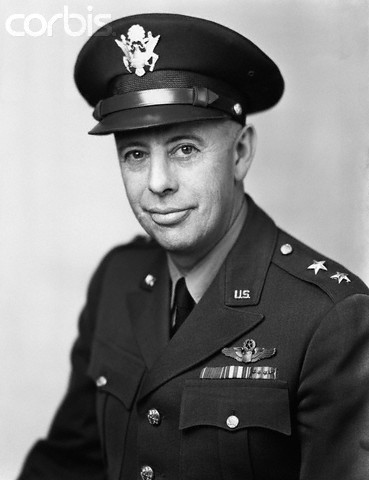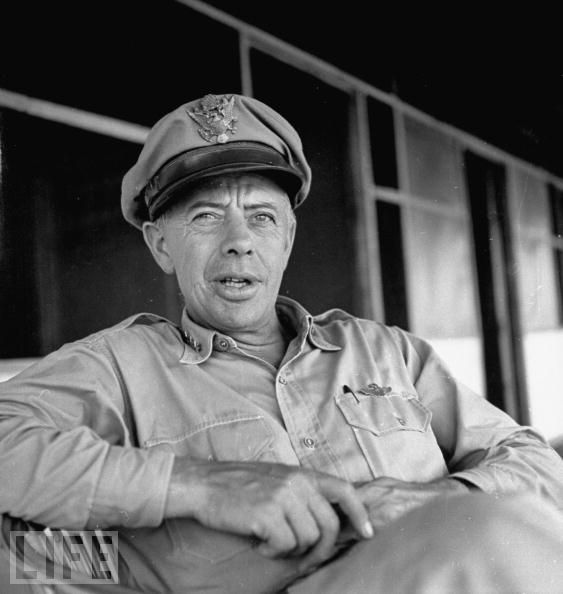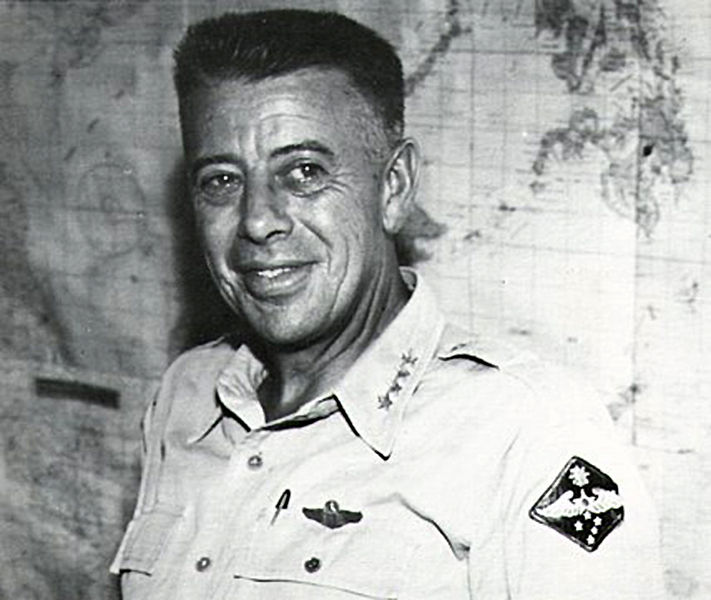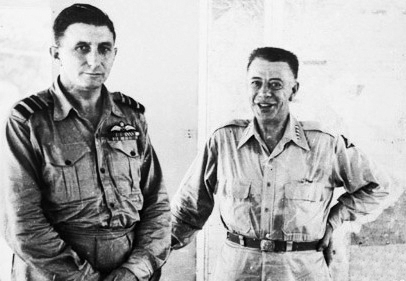<Back to Index>
- Geophysicist Cecil Howard Green, 1900
- Singer and Composer Barbara Strozzi, 1619
- General of the U.S. Army Air Forces George Churchill Kenney, 1889
PAGE SPONSOR


George Churchill Kenney (6 August 1889 – 9 August 1977) was a United States Army Air Forces general during World War II. He was commander of the Allied air forces in the Southwest Pacific Area (SWPA) from August 1942 until 1945.
Kenney was born in Yarmouth, Nova Scotia, Canada, grew up in Brookline, Massachusetts, and graduated from Brookline High School in 1907. He left MIT after three years to take a job at Quebec Saguenay Railroad as an instrument technician. In June 1917 he enlisted as a flying cadet in the Aviation Section, U.S. Signal Corps, where he received flight training from noted aviator Bert Acosta. As a lieutenant in France during World War I, Kenney flew 75 combat missions and shot down two German aircraft while serving with the 91st Aero Squadron. (It is believed that one of the two German pilots he shot down was Hermann Göring, later the head of the Luftwaffe in World War II.) After the war, Kenney remained for a time with the Allied occupation forces in Germany. He was promoted to Captain in 1919 and was appointed commander of the 91st Aero Squadron.
During the 1920s and 1930s, Kenney attended the Command and General Staff College at Fort Leavenworth, Kansas, and the Army War College in Washington, D.C. From September 1927 to July 1931 he was an instructor at the Air Corps Tactical School. He was also involved in surveying airfield sites in Puerto Rico and the U.S. Virgin Islands. Kenney was active in aeronautical research and development during this period, and pioneered the use of machine guns mounted in the wings of Air Corps pursuit planes.
By 1939, Kenney, now a Lieutenant Colonel, commanded the Air Corps Experimental Division and Engineering School at Wright Field, Ohio. In 1940 he went to France as U.S. Assistant military attaché for Air to observe Allied air operations during the early stages of World War II.
As a result of his observations, he recommended many important changes
to U.S. Air Corps combat tactics. In 1941, Kenney was promoted to Brigadier General and was made commander of the Fourth Air Force, an air defense organization based in California. In
August 1942, as a major general, Kenney took over command of both the
Allied Air Forces in the SWPA (South West Pacific Area) and the
newly formed US Fifth Air Force, thereby becoming the senior Allied air officer under overall theater commander General Douglas MacArthur. Initially from his headquarters in Brisbane, Australia, and later from New Guinea and the Philippines, Kenney commanded American, Royal Australian Air Force, British Royal Air Force and Dutch air units. For three years he directed the air war against Japanese positions in and around New Guinea (including the surrounding islands), the Dutch East Indies, Borneo, and the Philippines. He was promoted to lieutenant general in October 1942. One of Kenney's most successful air operations was the destruction of a major Japanese reinforcement fleet during the Battle of the Bismarck Sea in
1943. The loss of most of this huge armada, loaded with supplies and
troop reinforcements, ended Japanese hopes of retaining control of New
Guinea. In 1944 Kenney was appointed commander of the revived US Far East Air Force (FEAF), which came to include the Fifth, Thirteenth, and Seventh Air Forces. After the liberation of the Philippines, units under Kenney's command took part in the battles of Iwo Jima and Okinawa.
C-46 and C-47 transport aircraft of the FEAF were the first American
planes to land in Japan following the Japanese surrender on September
2, 1945. Kenney
received the four stars of a full general on 9 March 1945, and after
World War II served in Europe as a staff officer. In April 1946 he
became the first commander of the newly formed Strategic Air Command (SAC),
but chose to spend most of his time in the political battle surrounding
the establishment of an independent United States Air Force. As a
result, SAC's efficiency suffered. In 1948 Lieutenant General Curtis LeMay replaced Kenney as commander of SAC. Kenney then served as commander of the Air University until his retirement in 1951. During a career which spanned over 30 years, Kenney was awarded the Distinguished Service Cross with one oak leaf cluster, the Distinguished Service Medal with one oak leaf cluster, the Silver Star, the Distinguished Flying Cross, the Purple Heart (for meritorious service, not wounds), and several foreign decorations. After his retirement, Kenney lived in Bay Harbor Islands, Florida, where he died in 1977. He is survived by five sons and one daughter. Kenney wrote three books about the SWPA air campaigns he led during World War II. His major work was General Kenney Reports, a personal history of the air war he led from 1942 to 1945. He also wrote The Saga of Pappy Gunn and Dick Bong: Ace of Aces,
which described the careers of two of the most prominent airmen under
his command (P-38 pilot Major Richard I. Bong remains the top scoring
American ace of all time, having shot down 40 Japanese planes).

